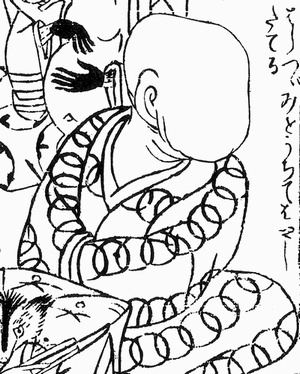 | ||
The Noppera-bō (のっぺら坊, Noppera-bō), or faceless ghost, is a Japanese yōkai (legendary creature) that looks like a human but has no face. They are sometimes mistakenly referred to as a mujina, an old Japanese word for a badger or raccoon dog. Although the mujina can assume the form of the other, noppera-bō are usually disguised as humans. Such creatures were thought to sometimes transform themselves into noppera-bō in order to frighten humans. Lafcadio Hearn used the animals' name as the title of his story about faceless monsters, probably resulting in the misused terminology.
Contents
- Noppera b in legends
- The Noppera b and the Koi Pond
- The Mujina of the Akasaka Road
- Noppera b in popular culture
- Recent reports
- References
Noppera-bō are known primarily for frightening humans, but are usually otherwise harmless. They appear at first as ordinary human beings, sometimes impersonating someone familiar to the victim, before causing their features to disappear, leaving a blank, smooth sheet of skin where their face should be.
Noppera-bō in legends
Often, a noppera-bō would not actually exist, but was the disguise of a mujina, a fox kitsune, or a tanuki. In Showa 4 (1767), in the kaidan collection Shinsetsu Hyakumonogatari, there were stories that told of how in Nijugawara in Kyoto (near the Nijo-ohashi bridge in the Nakagyō-ku, Kyoto), a monster called noppera-bō appeared and those that were attacked by it would have several thick hairs attached to their clothing, indicating that it was the disguise of some kind of animal. However, sometimes their real identity is not known, and in the Kanbun 3 (1663) kaidan collection Sorori Monogatari, it was written that in the Oike-cho of the capital (now Nakagyō-ku, Kyoto), there appeared a noppera-bō with a height of about 7 shaku (about 2.1 meters), but nothing was written about what its true identity was. They are also said to appear in folktales in the Osaka Prefecture and Kotonami, Nakatado District, Kagawa Prefecture among other places.
The Noppera-bō and the Koi Pond
This tale recounts a lazy fisherman who decided to fish in the imperial koi ponds near the Heian-kyō palace. Despite being warned by his wife about the pond being sacred and near a graveyard, the fisherman went anyway. On his way to the pond, he is warned by another fisherman not to go there, but he again ignores the warning. Once at the spot, he is met by a beautiful young woman who pleads with him not to fish in the pond. He ignores her and, to his horror, she wipes off her face. Rushing home to hide, he is confronted by what seems to be his wife, who chastises him for his wickedness before wiping off her facial features as well.
The Mujina of the Akasaka Road
The most famous story recollection of the Noppera-bō comes from Lafcadio Hearn's book Kwaidan: Stories and Studies of Strange Things titled Mujina. The story of a man who travelled along the Akasaka road to Edo, he came across a young woman in a remote location near Kunizaka hill, crying and forlorn. After attempting to console the young woman and offer assistance, she turned to face him, startling him with the blank countenance of a faceless ghost. Frightened, the man proceeded down the road for some time, until he came across a soba vendor. Stopping to relax, the man told the vendor of his tale, only to recoil in horror as the soba vendor stroked his face, becoming a noppera-bō himself. It turns out that all of these noppera-bō were really just mujina in disguise.
There are other tales about noppera-bō, from a young woman rescued from bandits by a samurai on horseback whose face disappears; to stories of nobles heading out for a tryst with another, only to discover the courtesan is being impersonated by a noppera-bō.
Noppera-bō in popular culture
Recent reports
Although most tales of noppera-bō predate the 20th century, there are exceptions, both in Japan itself as well as locations where Japanese have emigrated, most notably the U.S. state of Hawaii. Among the most recent reports:
